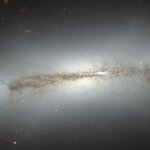Space

Astronomers have identified the glowing wreck of a star that exploded a mere 2,500 years ago — the blink of an eye in astronomical terms - and revealed an astrophysical novelty of the Milky Way.
Situated in the plane of the Milky Way 24,000 to 30,000 light years from Earth in the constellation Circinus, the neutron dubbed Circinus X-1 is what astronomers call an X-ray binary, a system where an evolving star and a black hole or neutron star closely orbit one another and produce X-rays as material from the evolving star spirals in to its denser companion and is heated to very high…

A model has shown that the subsurface ocean on Jupiter's moon Europa may have deep currents and circulation patterns with heat and energy transfers capable of sustaining biological life.
Astronomers believe Europa is one of the planetary bodies in our solar system most likely to have conditions that could sustain life, an idea reinforced by magnetometer readings from the Galileo spacecraft detecting signs of a salty, global ocean below the moon's icy shell. Without direct measurements of that ocean, scientists have to rely on magnetometer data and observations of the moon's icy surface to…

Separate teams of scientists have found faint signatures of water in the atmospheres of five distant planets, the first study to conclusively measure and compare the profiles and intensities of these signatures on multiple worlds.
The five planets - WASP-17b, HD209458b, WASP-12b, WASP-19b and XO-1b - are hot Jupiters, massive worlds that orbit close to their stars. The strengths of their water signatures varied. WASP-17b, a planet with an especially puffed-up atmosphere, and HD209458b had the strongest signals. The signatures for the other three planets, WASP-12b, WASP-19b and XO-1b,…

In boxing a devastating puncher has heavy hands. On a cosmic scale, the high-speed 'jets' spat out by black holes pack a lot of power because they contain heavy atoms, astronomers have found. Black-hole jets recycle matter and energy into space and can affect when and where a galaxy forms stars.
Astronomers have known for decades that black-hole jets contain electrons, which are low-mass particles, but using the European Space Agency's XMM-Newton space telescope and CSIRO's Compact Array radio telescope in northwest NSW, a research team found the first evidence of heavy atoms — iron and…

Our Galaxy may have been swallowing "pills" — clouds of gas with a magnetic wrapper — to keep making stars for the past eight billion years, according to CSIRO astronomer Dr. Alex Hill and colleagues, in their study of the Smith Cloud, a large gas cloud falling into our Galaxy from intergalactic space.
Named after its discoverer, Gail Bieger (née Smith), the Smith Cloud is at least two million times the mass of our Sun. If it were visible to the naked eye, it would look 20 times wider than the full Moon. The Smith Cloud is one of thousands of "high velocity clouds" of hydrogen gas flying…

A few months ago astronomers created a new 3-D map of stars at the center of our Galaxy which cleared showed the bulge at its core.
Previous explanations suggested that the stars that form the bulge are in banana-like orbits, but a paper published in Monthly Notices of the Royal Astronomical Society suggests that the stars probably move in peanut-shell or figure of eight-shaped orbits instead.
The difference is important when we're trying to figure out not just star motion but and how the stars in our galaxy are moving today, but also how our galaxy formed and evolves. The Milky Way is…

When a star goes supernova, it shines brightly for a few weeks or months before fading away. Yet the material blasted outward from the explosion glows hundreds or thousands of years later, leaving a picturesque supernova remnant. But how?
Tycho's supernova was witnessed by astronomer Tycho Brahe in 1572. The appearance of this "new star" stunned those who thought the heavens were constant and unchanging. At its brightest, the supernova rivaled Venus before fading from sight a year later. Modern astronomers know that the event Tycho and others observed was a Type Ia supernova, caused by the…

Recently, a gamma-ray burst occurred with an optical flash that peaked at magnitude 7 on the astronomical brightness scale, easily visible through binoculars. It is the second-brightest flash ever seen from a gamma-ray burst.
On April 27th, a blast of light from a dying star in a distant galaxy became the focus of astronomers around the world. The gamma-ray burst was designated GRB 130427A and a trio of NASA satellites, working in concert with ground-based robotic telescopes, captured never-before-seen details that challenge current theoretical understandings of how gamma-ray…

Astronomers from around the world have used data from satellites and observatories to explain the brightest Gamma-ray Burst (GRB) ever recorded.
An unusually bright GRB, now deemed GRB 130427A, was observed on April 27th 2013 by the Swift satellite and was then found this be a result of an extremely powerful stellar explosion. This explosion produced a jet of matter moving close to the speed of light, which was formed when a massive star collapsed to make a black hole at its centre. As a result, a blast wave caused the rest of the star to expand outwards, producing a glowing shell of debris…

Neutrinos can pass right through your body, the walls of your house, entire planets, even emerging from near the surface of fascinating and frightening black holes.
And now, an international scientific collaboration using the IceCube Neutrino Observatory telescope built over a mile deep in the Antarctic ice has taken an 'astronomical' step forward in unmasking the origins of some of these high-energy particles, the so-called "messengers of the universe."
The researchers have observed 28 very high-energy particle events and they constitute the first solid evidence of neutrinos…